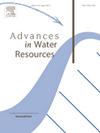A data-driven physics-informed deep learning approach for estimating sub-core permeability from coreflooding saturation measurements
IF 4
2区 环境科学与生态学
Q1 WATER RESOURCES
引用次数: 0
Abstract
Estimations of multi-phase flow properties, mainly permeability, are crucial for several applications, such as CO sequestration, efficient oil and gas recovery, and groundwater contaminant treatment. Current methods for estimating the sub-core scale properties rely on numerical simulations, which can be time-consuming. A suitable alternative to numerical simulations is Deep Neural Networks (DNN), where the system is trained to relate between the input and output parameters, thus providing fast predictions of dynamic, complex systems. Nevertheless, standard DNN cannot yield robust results when data is scarce. Physics-Informed Neural Networks (PINN) is a class of DNN that incorporate physical penalties to train the system. PINN were mainly applied and found robust in solving inverse problems with limited information. Nevertheless, using PINN for inversion is limited to a specific scenario and retraining the system is required when applied to different settings. Few studies have trained a PINN system as a surrogate model, thus quickly solving a forward problem under variable conditions. In this work, we coupled a surrogate PINN system with a data-driven DNN to estimate a 1D heterogeneous permeability profile with sub-core saturation measurements. A previously trained PINN system for solving a 1D steady-state two-phase flow problem with capillary heterogeneity at altering flow conditions was applied to generate a vast database for training a data-driven DNN that links the permeability, flow conditions and measured saturations at the sub-core level. Given the flow conditions and measured saturations, the two trained systems were coupled to rapidly predict a 1D permeability profile. It was found to be robust and accurate when confronted with the actual 1D permeability profiles where average misfits were lower than 1%. Due to the approach’s rapidness in solving the inverse problem, an extension for a stochastic solution was suggested to cope with contaminated data, enhancing outcome accuracy and providing uncertainty in less than 15 s. The coupled approach was also found to be robust in producing 1D permeability structures from 3D data and was able to generate 1D saturation profiles at altering conditions with an average misfit of 3%.
一种数据驱动的物理信息深度学习方法,用于从岩心注水饱和度测量中估计岩心下渗透率
多相流特性(主要是渗透率)的估计对于CO2封存、高效油气开采和地下水污染物处理等应用至关重要。目前估计亚岩心尺度性质的方法依赖于数值模拟,这可能是耗时的。数值模拟的一个合适的替代方案是深度神经网络(DNN),其中系统被训练为在输入和输出参数之间建立联系,从而提供动态复杂系统的快速预测。然而,当数据稀缺时,标准深度神经网络不能产生可靠的结果。物理信息神经网络(PINN)是DNN的一类,它结合了物理惩罚来训练系统。PINN主要用于求解信息有限的逆问题,具有鲁棒性。然而,使用PINN进行反演仅限于特定的场景,并且当应用于不同的设置时需要对系统进行重新训练。很少有研究将PINN系统训练为代理模型,从而快速解决变条件下的正演问题。在这项工作中,我们将替代PINN系统与数据驱动的DNN相结合,通过亚岩心饱和度测量来估计一维非均质渗透率剖面。先前训练的PINN系统用于解决在改变流动条件下具有毛细管非均质性的一维稳态两相流问题,用于生成一个庞大的数据库,用于训练数据驱动的DNN,该DNN将渗透率、流动条件和亚岩心水平的测量饱和度联系起来。考虑到流体条件和测量的饱和度,将两个训练过的系统结合起来,快速预测一维渗透率剖面。当实际的一维渗透率曲线平均失配小于1%时,发现该方法是可靠和准确的。由于该方法求解逆问题的速度快,提出了一种随机解的扩展,以应对污染数据,提高结果的准确性,并在小于15秒的时间内提供不确定性。研究还发现,耦合方法在从3D数据生成1D渗透率结构方面也很稳健,并且能够在平均失配约3%的变化条件下生成1D饱和度剖面。
本文章由计算机程序翻译,如有差异,请以英文原文为准。
求助全文
约1分钟内获得全文
求助全文
来源期刊

Advances in Water Resources
环境科学-水资源
CiteScore
9.40
自引率
6.40%
发文量
171
审稿时长
36 days
期刊介绍:
Advances in Water Resources provides a forum for the presentation of fundamental scientific advances in the understanding of water resources systems. The scope of Advances in Water Resources includes any combination of theoretical, computational, and experimental approaches used to advance fundamental understanding of surface or subsurface water resources systems or the interaction of these systems with the atmosphere, geosphere, biosphere, and human societies. Manuscripts involving case studies that do not attempt to reach broader conclusions, research on engineering design, applied hydraulics, or water quality and treatment, as well as applications of existing knowledge that do not advance fundamental understanding of hydrological processes, are not appropriate for Advances in Water Resources.
Examples of appropriate topical areas that will be considered include the following:
• Surface and subsurface hydrology
• Hydrometeorology
• Environmental fluid dynamics
• Ecohydrology and ecohydrodynamics
• Multiphase transport phenomena in porous media
• Fluid flow and species transport and reaction processes
 求助内容:
求助内容: 应助结果提醒方式:
应助结果提醒方式:


